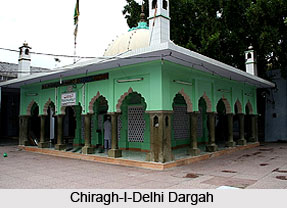 Chirag-e-Delhi Dargah is situated within the village of Chiragh, Delhi on Maulaviya Nagar, Kalkaji Road. Situated in South Delhi, the dargah is circled by a typically charming urban village consisting of shaving salons, gyms, groceries, corner temples and stray dogs. Yet, it has managed to shelter its enclosed world in a state of solemn seclusion. Gradually the township grew up about the Tomb of Nasiruddin Mahmud. He was bestowed with the title of "Roshan Chiragh-e-Dilli" meaning "illuminated lamp of Delhi". He was a disciple of Hajrat Nizamuddin Auliya and later succeeded him and became the head of the Chishti Order. He was the last important Sufi of the Chishti Order from Delhi.
Chirag-e-Delhi Dargah is situated within the village of Chiragh, Delhi on Maulaviya Nagar, Kalkaji Road. Situated in South Delhi, the dargah is circled by a typically charming urban village consisting of shaving salons, gyms, groceries, corner temples and stray dogs. Yet, it has managed to shelter its enclosed world in a state of solemn seclusion. Gradually the township grew up about the Tomb of Nasiruddin Mahmud. He was bestowed with the title of "Roshan Chiragh-e-Dilli" meaning "illuminated lamp of Delhi". He was a disciple of Hajrat Nizamuddin Auliya and later succeeded him and became the head of the Chishti Order. He was the last important Sufi of the Chishti Order from Delhi.
Biography of Nasiruddin Mahmud
Chiragh Dehlavi was born as Nasiruddin around 1274, at Ayodhya, Uttar Pradesh. Nasiruddin Mahmud was a spiritual man as well as a 14th-century mystic-poet and a Sufi saint. He has greatly contributed immensely towards the development and growth of Urdu poetry. His father, Syed Yahya, who traded in Pashmina, and his grandfather, Syed Abdul Latif, first migrated from Khorasan, northeastern Iran, to Lahore, and thereafter settled in Ayodhya, in Awadh. His father died when he was only nine years of age and he received his early education from Maulana Abdul Karim Sherwani, and later continued it with Maulana Iftikhar Uddin Gilani.
After miraculously lighting earthen lamps with water (instead of oil), Hazrat Naseeruddin acquired the title of "Roshan Chiarg Dilli", the bright lamp of Delhi.
At age forty, he left Ayodhya for Delhi, where he became the disciple of Khwaja Nizamuddin Auliya. It was here that he stayed for the rest of his life as his murid (disciple), and after his death, became his successor. In time, he also became a known poet in Persian language.
The saint left for his holy abode in the year 1356, at the age of 82, and is buried in a part of South Delhi, India which is known as "Chirag-e-Delhi" after him. He was buried in the chamber in which he lived. His master Hazrat Nizamuddin"s cloak and sandals were placed on his body. Today, his grave looks up to a chandelier.
Architecture of the Dargah
Earlier the village remained enclosed within large rubble built rectangular enclosure. This chamber was created by Muhammad Bin Tughlaq. Later he also added a modest gateway on both sides with the tomb. However, many repair and renovation work has taken place here on several occasions. Now, a twelve pillared square chamber that is enclosed within perforated screens consists of the tomb of Nasiruddin Mahmud. The chamber has four tiny domed towers in the corners. It is surmounted by a plastered dome that rises from an octagonal drum. After some time many other structures like Majlis Khana (assembly hall), Mahfil Khana (symposium hall), had been added towards the Delhi Chirag-e-Delhi Dargah.
The tomb is rarely crowded. The dome is painted white and the walls are green. The niches have earthen lamps. The foliage of a grand khirni tree provides shade to a section of the courtyard. In summer, earthen water pots are kept around its trunk.
The construction also houses of a graveyard. This graveyard has graves and tombs of several eminent personalities. One can also see a number of mosques that are located within the premises of the dargah. One of these mosques was developed by King Farrukhsiyar, in the early 18th century. It was erected in honour of Nasiruddin Mahmud.
Prayer at the Dargah
During the prayer hours, the devotees turn to the direction of Mecca. The rest of the time they sit quietly in front of the shrine - eyes closed. Sometimes, a khadim - the dargah"s traditional caretaker - is requested to liberate a man possessed by djinns. The khadim gently sways peacock"s feathers over the afflicted man"s head and orders the unseen spirits to go away.
Heritage
Nasiruddin Chiragh Dehalvi, unlike his spiritual master Nizamuddin Auliya, did not listen to sema, which was considered un-Islamic by a section of the Muslim intelligentsia in that period. He did not however pass any specific judgement against it. This is the reason why even today, "qawwali" is not performed near his shrine in Delhi.
Connectivity to the Mosque
Being the capital of India, Delhi is well connected to all the major cities through the Indira Gandhi International Airport. The nearest railway station in Delhi is the Nizamuddin Railway Station from where all the cities in the country are connected to. Even the city of Delhi is facilitated with the Nearest Metro Station which is at Central Secretariat.



















